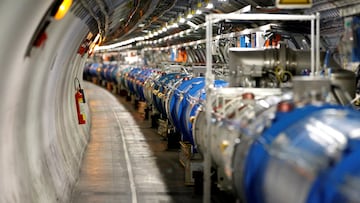What are the three new exotic particles that CERN scientists have observed thanks to the Large Hadron Collider?
New never before seen particles have been observed by scientists during the use of Europe’s Large Hadron Collider, the world’s largest particle-smasher.

The Large Hadron Collider (LHC), the largest particle smasher in the world has led physicists to identify three never before seen particles during the latest round of high energy tests. A particle collider can help scientists better understand the structure of the subatomic world which is impossible to witness with the naked eye. These machines use high amounts of enegy over a short period of time to make these observations. The scientists working on this machine are attempting to show that physics can move beyond the “Standard Model” to explain other theorized phenomena like dark matter. According to NASA, dark matter refers to materials that is “not in the form of stars and planets” and is not visible to us.
The LCH is found at European Organization for Nuclear Research, abbreviated as CERN.
Why are these tests happening now?
The LHC machine has been undergoing upgrades for the last three years and is now ready for to support new tests. The current round of testing will run through 2026.
“After over three years of upgrade and maintenance work, the LHC is now set to run for close to four years at the record energy of 13.6 trillion electronvolts (TeV), providing greater precision and discovery potential,” read CERA’s release.
These upgrades will allow for “increased collision rates, higher collision energy, upgraded data readout and selection systems, new detector systems and computing infrastructure,” which will “further expand the already very diverse LHC physics programme,” according to the organization.
What have they found so far?
Already the team is beginning to uncover new discoveries. On 5 July the team at CERA announced that they had identified “a new kind of “pentaquark” and the first-ever pair of “tetraquarks”, which includes a new type of tetraquark.” These come after scientists theorized these exotic hadrons more than six decades ago and finally they have evidence that they exist.
In a press release on the new finding, LHCb physics coordinator Niels Tuning stated that “the more analyses we perform, the more kinds of exotic hadrons we find.”
“We’re witnessing a period of discovery similar to the 1950s, when a ‘particle zoo’ of hadrons started being discovered and ultimately led to the quark model of conventional hadrons in the 1960s. We’re creating ‘particle zoo 2.0′” said Tuning.






